Transform Clinical Practice with These Steps of the Evidence-Based Process
Steps of the Evidence-Based Process
Formulate a Measurable Clinical Question
The first step in the evidence-based process is to formulate a measurable clinical question. This step is crucial as it lays the foundation for the entire evidence-based practice (EBP) process. Clinical questions often arise from real-world scenarios encountered by Advanced Practice Registered Nurses (APRNs) or staff nurses in their daily practice. These questions may emerge when faced with an uncertain intervention or managing a rare condition not covered by standard clinical guidelines.
A widely used model for formulating these clinical questions is the PICO(T) model, which stands for:
- P: Patient/Population/Problem
- I: Intervention
- C: Comparison
- O: Outcome
- T: Time (optional)
This model helps in clearly defining the elements of the question, making it easier to search for relevant evidence in the literature. For instance, if an APRN is exploring the effectiveness of telemedicine for patients with chronic conditions, the PICO framework would guide the formulation of a question such as: “In patients with chronic diabetes (P), how does telemedicine (I) compare with in-person visits (C) in managing blood sugar levels (O) over six months (T)?”
Search for the Best Available Evidence
After formulating the clinical question, the next step is to search for the best available evidence. This involves a systematic and comprehensive search of the literature to find studies and data that address the formulated question. The goal is to find high-quality evidence, such as randomized controlled trials (RCTs), systematic reviews, or meta-analyses that can provide reliable answers.
In this step, it is essential to use a variety of databases and resources to ensure a thorough search. Popular databases include PubMed, CINAHL, and Cochrane Library. The search should be strategic, using specific keywords and Boolean operators to narrow down results to the most relevant studies. The search strategy should be documented meticulously to allow replication and transparency.
Critically Appraise the Evidence
Once the relevant evidence is gathered, the third step is to critically appraise the evidence. This step involves evaluating the quality, validity, and applicability of the evidence to the clinical question. Critical appraisal is essential because not all evidence is created equal; some studies may have methodological flaws or biases that could impact the reliability of their findings.
During the critical appraisal, several factors should be considered:
- Study Design: Was the study design appropriate for the research question?
- Sample Size: Was the sample size adequate to detect a significant effect?
- Bias and Confounding: Were there any biases or confounding factors that could have influenced the results?
- Statistical Analysis: Was the statistical analysis conducted correctly?
By thoroughly appraising the evidence, healthcare professionals can ensure that they are basing their clinical decisions on the most reliable and relevant information.
Implement the Evidence in Practice
The final step in the evidence-based process is to implement the evidence in practice. This step involves integrating the critically appraised evidence with clinical expertise and patient preferences to make informed decisions that improve patient outcomes.
Implementation may require changes in clinical practice, which can be challenging. It is essential to consider the feasibility of applying the evidence in a specific clinical setting and to address any potential barriers. For example, if the evidence supports the use of a new intervention, healthcare providers may need to undergo training, or new protocols may need to be developed.
The implementation process should also include monitoring and evaluating the outcomes to ensure that the changes are having the desired effect. Continuous evaluation and feedback are crucial to refining the implementation and making necessary adjustments.
FAQs
Q: What is the most critical step in the evidence-based process?
A: All steps are important, but formulating a measurable clinical question is crucial as it guides the entire process.
Q: How can I ensure that the evidence I find is of high quality?
A: Conduct a thorough search in reputable databases and critically appraise the evidence for quality and applicability.
Q: What if the evidence contradicts current clinical practice?
A: It’s important to critically evaluate the evidence and consider its applicability to your specific context. If the evidence is strong, it may warrant a change in practice.
Q: How do I overcome barriers to implementing new evidence in practice?
A: Address potential barriers by providing training, developing protocols, and engaging stakeholders in the change process.
Q: What role do patient preferences play in the evidence-based process?
A: Patient preferences are integral to the process. The best evidence should be combined with clinical expertise and patient preferences to make informed decisions.
Table: The PICO(T) Model for Generating EBP Clinical Questions
| Component | Definition |
|---|---|
| P | Patient/Population/Problem: Identify the target group |
| I | Intervention: Identify the intervention to be considered |
| C | Comparison: Identify what the intervention will be compared to |
| O | Outcome: Identify the goal of the intervention |
| T | Time: Optional timeframe for measuring outcomes |
This table outlines the PICO(T) model components that are essential for generating precise and relevant clinical questions in the evidence-based process.

